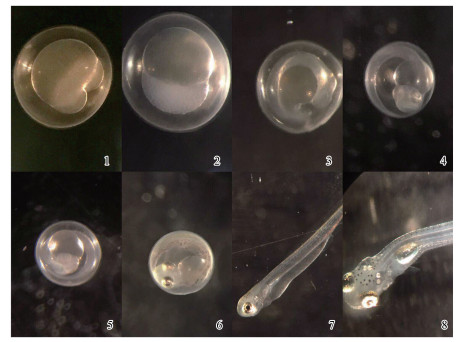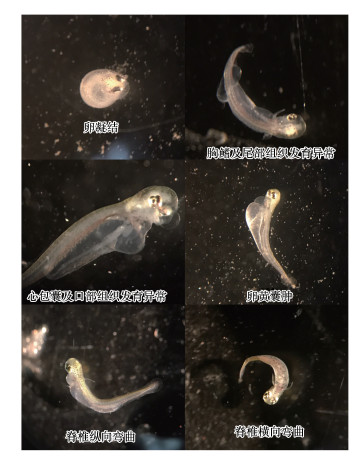 , 许玉洁1,2,3,4, 陈进林1,2,3,4, 梅承芳1,2,3,4, 陈桂兰1,2,3,4, 霍嘉维1,2,3,4, 刘桃妹1,2,3,4, 冯宝欣1,2,3,4, 余明喧1,2,3,4, 曾国驱1,2,3,4
, 许玉洁1,2,3,4, 陈进林1,2,3,4, 梅承芳1,2,3,4, 陈桂兰1,2,3,4, 霍嘉维1,2,3,4, 刘桃妹1,2,3,4, 冯宝欣1,2,3,4, 余明喧1,2,3,4, 曾国驱1,2,3,4

1. 广东省科学院, 广东省微生物研究所, 广州 510070;
2. 华南应用微生物国家重点实验室, 广州 510070;
3. 广东省菌种保藏与应用重点实验室, 广州 510070;
4. 广东省微生物应用新技术公共实验室, 广州 510070
收稿日期: 2019-07-27; 修回日期: 2019-08-30; 录用日期: 2019-08-30
基金项目: 广州市科技计划项目(No.201707010162);广东省重点领域研发计划(No.2019B110205004)
作者简介: 高亮(1986—), 男, E-mail:gao_liang_gz@sina.com
通讯作者(责任作者): 曾国驱, E-mail:zengguoqu@163.com
摘要:随着非甾体抗炎药(NSAIDs)的持续使用与排放,世界各地的地表水、海水、地下水、污水厂进出水中均已频繁检测到该类药物,这对生态系统中各种非靶标生物造成了一定威胁.本研究评价了两种典型的非甾体抗炎药-双氯芬酸(Diclofenac)和醋氨酚(Acetaminophen)对中国特有物种稀有鮈鲫(Gobiocypris rarus)早期生活阶段的毒性效应.实验结果显示,醋氨酚的毒性较弱,当浓度达到48.4 mg·L-1(NOEC)时,稀有鮈鲫的孵化率、死亡率、异常率、全长和干重均未表现出明显的中毒症状;而双氯酚酸的毒性则较强,当浓度达17.8 mg·L-1(LC10)时,即可导致稀有鮈鲫孵化率下降,当浓度达到10.2 mg·L-1(LOEC)时,即可造成幼鱼外观和行为的显著异常,表明双氯芬酸对稀有鮈鲫的孵化和生长均产生了一定的致毒效应.同时,根据稀有鮈鲫和几种常用模式生物之间的孵化率、孵化后存活率、体长和双氯芬酸敏感性的比较结果,可认为稀有鮈鲫适用于污染物对鱼类早期生活阶段毒性效应的评估.
关键词:非甾体抗炎药双氯芬酸醋氨酚稀有鮈鲫鱼类早期生活阶段毒性试验
Toxicity effects of diclofenac and acetaminophen to the early-life stage of Chinese Rare Minnow (Gobiocypris rarus)
GAO Liang1,2,3,4
 , XU Yujie1,2,3,4, CHEN Jinlin1,2,3,4, MEI Chengfang1,2,3,4, CHEN Guilan1,2,3,4, HUO Jiawei1,2,3,4, LIU Taomei1,2,3,4, FENG Baoxin1,2,3,4, YU Mingxuan1,2,3,4, ZENG Guoqu1,2,3,4
, XU Yujie1,2,3,4, CHEN Jinlin1,2,3,4, MEI Chengfang1,2,3,4, CHEN Guilan1,2,3,4, HUO Jiawei1,2,3,4, LIU Taomei1,2,3,4, FENG Baoxin1,2,3,4, YU Mingxuan1,2,3,4, ZENG Guoqu1,2,3,4

1. Guangdong Institute of Microbiology, Guangdong Academy of Sciences, Guangzhou 510070;
2. State Key Laboratory of Applied Microbiology Southern China, Guangzhou 510070;
3. Guangdong Provincial Key Laboratory of Microbial Culture Collection and Application, Guangzhou 510070;
4. Guangdong Open Laboratory of Applied Microbiology, Guangzhou 510070
Received 27 July 2019; received in revised from 30 August 2019; accepted 30 August 2019
Abstract: Due to the continuous use and emission, the nonsteroidal anti-inflammatory drugs (NSAIDs) have been frequently detected in the natural surface water, seawater, groundwater and the inlet and outlet water of sewage treatment plants, which has posed a threat to a variety of non-target organisms in the ecosystem. In this study, we evaluated the toxicity of two typical NSAIDs, acetaminophenand diclofenac, on the early-life stage of Chinese Rare Minnow (Gobiocypris rarus), a Chinese endemic species. No significant toxic effect on the hatching rate, mortality, abnormal rate, total length and dry weight of Rare Minnow was observed when the acetaminophen concentration increased from 0 to 48.4 mg·L-1. In contrast, diclofenac caused a significant decrease in the hatching rate of Rare Minnow at the concentration of 17.8 mg·L-1 (LC10). The lowest observed effective concentration (LOEC) that caused abnormal appearance and behavior of larvae was 10.2 mg·L-1, indicating that diclofenac had significant toxicity on the hatching and growth of the fish. By comparing the hatching rate, survival rate post-hatching, body length and sensitivity to diclofenac of Chinese Rare Minnow and several other model organisms, Chinese Rare Minnow could be considered to be a new model organism for evaluating the early-life stage toxicity of aquatic pollutants to fish.
Keywords: nonsteroidal anti-inflammatory drugsdiclofenacacetaminophenGobiocypris rarusfish early-life stage toxicity test
1 引言(Introduction)非甾体抗炎药(Nonsteroidal Anti-inflammatory Drugs, NSAIDs)是一类具有抗炎、抗风湿、止痛、退热和抗凝血等作用的药物, 在临床上被广泛用于多种发热和各种疼痛症状的缓解.NSAIDs的种类繁多、使用量大, 每年的处方量多达5亿(严清等, 2012).如典型的苯胺类药物醋氨酚, 据估计其年销量达240 t(Wiegel et al., 2004), 而芳基乙酸类药物双氯芬酸, 全球每年消耗量更是高达940 t, 但其在污水处理厂中的去除率大部分仅有21%~ 40%(Zhang et al., 2008), 导致其在环境中频繁检出而备受关注.随着该类药物的持续使用与排放, 在包括我国珠江、黄河、辽河、海河在内的世界多地的地表水, 还有各地的海水、地下水、污水厂进出水中均有检出(Sacher et al., 2002;Zhao et al., 2009;Wang et al., 2010;张正华等, 2015).在某些污水处理厂的进出水中, NSAIDs的浓度可达到μg·L-1甚至mg·L-1级别(Lin et al., 2009;Pereira et al., 2015;Paíga et al., 2016;Gaffney et al., 2017).由于持续大量的排放, NSAIDs对生态系统产生了一定的负面影响.有研究显示, 环境中的双氯芬酸是导致巴基斯坦秃鹰种群急剧减少的重要原因(Oaks et al., 2004), 布洛芬则会对某些鱼类的内分泌产生干扰(Gravel et al., 2006).而且, 某些NSAIDs对水生生物存在着生物富集效应(Schwaiger et al., 2004;Ericson et al., 2010), 其浓度和危害可能随着食物链而被放大.显然, 生态系统中NSAIDs的危害逐渐得到重视, 目前已有关于NSAIDs对菌类、溞类、藻类、浮萍、虹鳟鱼、斑马鱼等多种环境生物的急性和慢性毒性研究(Beno?t et al., 2003;Cleuvers, 2003).然而, 在我国人口众多、NSAIDs使用量必定日益增加, 以及自然环境中的药物污染情况亦将日渐突出的情况下, 却少有关于国内NSAIDs污染的报道, 更未见使用我国特有水生物种评价NSAIDs毒性效应的研究.
稀有鮈鲫(Gobiocypris rarus), 属于鲤形目鲤科鮈鲫属, 是我国特有鱼种, 具有体型小、生活周期短、性成熟周期快、可连续产卵, 以及温度、溶氧和硬度耐受范围广等特点(王剑伟等, 2017).稀有鮈鲫对重金属、VOCs、苯胺类、含氯消毒剂和农药类等化学品非常敏感(吴本丽等, 2014;梁艺怀等, 2017;范博等, 2019), 且其对标准化测试中所常用的参比物重铬酸钾及3, 4-二氯苯胺的敏感性具有很好的重复性和稳定性(环境保护部化学品登记中心, 2013;张京佶等, 2014;OECD, 2019).因此, 稀有鮈鲫目前已被广泛用于水生生物的生态毒理学研究, 成为我国特有的模式生物之一.鱼类的早期生命阶段对外界污染物暴露非常敏感, 国际上其他小型鱼类如斑马鱼等的鱼卵, 均被广泛用于环境污染物的发育毒性研究(Brandhof et al., 2010;Xia et al., 2017).然而, 目前针对环境中NSAIDs对稀有鮈鲫鱼早期生命阶段的毒性研究, 国内外却鲜有报道(史晋绒等, 2014;周家辉等, 2019).
因此, 本研究采用我国特有鱼类稀有鮈鲫, 参考经济合作与发展组织(Organisation for Economic Co-operation and Development, OECD)的标准测试方法(OECD, 2013), 研究双氯芬酸和醋氨酚两种非甾体抗炎药对稀有鮈鲫早期生活阶段的毒性效应, 并籍此评估稀有鮈鲫早期生活阶段对污染物毒性测试的适用性, 以期为污染物的水环境毒理学效应评价提供重要的科学数据.
2 材料与方法(Materials and methods)2.1 标准品双氯芬酸(Diclofenac), 纯度> 98%, 醋氨酚(Acetaminophen), 纯度≥99%, 均购自Sigma-Aldrich.
2.2 实验生物稀有鮈鲫(Gobiocypris rarus)种鱼引自西南大学, 由本实验室长期驯养并繁殖获得试验用的亲鱼.亲鱼使用曝气除氯自来水驯养, 光照条件为14 h光照/10 h黑暗, 水温保持在(25± 2) ℃范围内, 溶解氧浓度维持在80%以上.亲鱼雄性和雌性1:1配对养殖, 于实验开始时通过人工受精获得受精卵, 挑选处于卵裂期、形态完好的受精卵进行暴露, 受精卵受精后2 h内开始暴露.
2.3 饲料使用丰年虫(Artemia salina)作为鱼的饲料.丰年虫卵购自山东贝森饲料有限公司, 使用人工海水孵化获得.
2.4 实验方法实验方法参考OECD的化学品测试指南中Test No. 210: Fish, Early-Life Stage Toxicity Test的方法进行.实验体系使用曝气除氯自来水制备, 先使用曝气除氯自来水配制浓度为100 mg·L-1的双氯芬酸贮备液和200 mg·L-1的醋氨酚贮备液, 再按浓度间隔系数稀释成各组使用液.根据预实验结果, 双氯芬酸的实验以2.943为间隔系数, 设计5个浓度分别为0.40、1.18、3.46、10.2和30.0 mg·L-1的处理组和1个空白对照组;醋氨酚的实验以1.691为间隔系数, 设计6个浓度分别为3.50、5.92、10.0、16.9、28.6和48.4 mg·L-1的处理组和1个空白对照组.每组设3个平行, 每个平行放入20颗受精卵.受精卵孵化前每个实验容器的溶液体积为250 mL, 孵化后每个实验容器的溶液体积为2 L, 水温控制在(25±2) ℃范围内, 光照条件为14 h光照/10 h黑暗, 溶解氧含量维持在60%以上.实验过程中每天更换一次试验溶液, 受精卵孵化后每天投喂一次丰年虫, 每天清理一次食物残渣.双氯芬酸的实验周期为35 d, 醋氨酚的实验周期为33 d, 实验过程每天观察受精卵的形态、孵化率和死亡率, 受精卵孵化后每天观察幼鱼的行为异常、外观异常和死亡率.实验过程中采用高效液相色谱仪测定两种药品在暴露溶液中的实际浓度.实验结束时, 测定存活幼鱼的全长和干重.
2.5 数据统计使用SPSS(20.0版本)软件的Chi-square test对受精卵的孵化率、总死亡率和总异常率进行显著性检验, 评估双氯芬酸和醋氨酚对稀有鮈鲫孵化率、死亡率和异常率的无可观测效应浓度(NOEC)和最低可观测效应浓度(LOEC).用Shapiro-Wilk test和Levene′s test判断存活幼鱼的全长和干重是否服从正态分布及是否具有方差齐性, 对不服从正态分布的数据使用Normal Score方法进行转换.用Dunnett′s test对幼鱼全长和干重进行显著性检验, 评估其NOEC和LOEC.用概率法(EPA PROBIT ANALYSIS PROGRAM Version 1.5), 计算双氯芬酸对稀有鮈鲫孵化率、死亡率和异常率的半数效应/致死浓度(ECx/LCx)及95%置信区间.
3 结果与讨论(Results and discussion)3.1 双氯芬酸对稀有鮈鲫早期生活阶段的影响实验结果如表 1和表 2所示, 当水中双氯酚酸浓度达到17.8 mg·L-1(LC10)时, 可使稀有鮈鲫的孵化率下降;当双氯芬酸浓度达到10.2 mg·L-1(LOEC)时, 可使稀有鮈鲫的死亡率和异常率显著增加;实验结束时, 各处理组中存活稀有鮈鲫幼鱼的全长和干重与空白对照组比较均无显著性差异, 表明双氯芬酸浓度在30.0 mg·L-1(NOEC)以下时, 对存活的稀有鮈鲫幼鱼的全长没有明显的抑制效应, 浓度在10.2 mg·L-1(NOEC)以下时, 对存活的稀有鮈鲫幼鱼的干重没有明显的抑制效应.
表 1(Table 1)
| 表 1 双氯芬酸对稀有鮈鲫孵化率、死亡率、异常率及全长、干重影响的观察结果 Table 1 Effects of diclofenac on the hatching rates, mortality, abnormal rates, total length and dry weight of Rare Minnow | ||||||||||||||||||||||||||||||||||||||||||||||||||||||||
表 1 双氯芬酸对稀有鮈鲫孵化率、死亡率、异常率及全长、干重影响的观察结果 Table 1 Effects of diclofenac on the hatching rates, mortality, abnormal rates, total length and dry weight of Rare Minnow
| ||||||||||||||||||||||||||||||||||||||||||||||||||||||||
表 2(Table 2)
| 表 2 双氯芬酸对稀有鮈鲫毒性效应值 Table 2 The toxicity effect value of Diclofenac to Rare Minnow | ||||||||||||||||||||||||||||
表 2 双氯芬酸对稀有鮈鲫毒性效应值 Table 2 The toxicity effect value of Diclofenac to Rare Minnow
| ||||||||||||||||||||||||||||
实验过程中, 稀有鮈鲫受精卵的外观异常主要表现为卵凝结;孵出后的稀有鮈鲫幼鱼表现出口部、尾部、胸鳍组织发育异常、脊椎弯曲、卵黄囊肿及心包囊肿的外观异常, 并观察到由此引起的静止不动、不协调的游动、原地打转及无法摄食的行为异常, 双氯芬酸浓度越高, 异常率越高.在本次实验中, 凡观察到外观异常的幼鱼均伴随行为异常, 且均在实验结束前死亡.正常稀有鮈鲫发育过程的观察见图 1, 发育异常的观察见图 2.表 3列出了暴露溶液中双氯芬酸的实际浓度, 结果显示其在本实验条件下比较稳定.
图 1(Fig. 1)
 |
| 图 1 正常稀有鮈鲫的发育过程 (1.二细胞卵裂期;2.多细胞卵裂期;3.尾鳍、眼晶体形成;4~5.头、尾部进一步发育, 心脏搏动, 身体摆动;6.眼囊形成, 身体黑色素产生;7~8.孵出) Fig. 1The development of the normal Chinese Rare Minnow (1~2-cell cleavage stage; 2.multicellular cleavage stage; 3.formation of tail fin and eye lens; 4~5.head, tail further development, heart pulsation, body swing; 6.optic vesicle and body melanin were generates; 7~8.hatchinging) |
图 2(Fig. 2)
 |
| 图 2 双氯芬酸实验过程中发育异常的稀有鮈鲫 Fig. 2The abnormal development of the Chines Rare Minnow in diclofenac experiment |
表 3(Table 3)
| 表 3 双氯芬酸的实测浓度 Table 3 The measured concentrations of Diclofenac | |||||||||||||||||||||||||||||||||||||||||||||||||||||
表 3 双氯芬酸的实测浓度 Table 3 The measured concentrations of Diclofenac
| |||||||||||||||||||||||||||||||||||||||||||||||||||||
3.2 醋氨酚对稀有鮈鲫早期生活阶段的影响实验结果如表 4所示, 各处理组中稀有鮈鲫的孵化率、死亡率、异常率、存活幼鱼的全长和体重与空白对照组比较均无显著性差异, 根据上述指标评估的NOEC均为48.4 mg·L-1, LOEC及LC50/EC50大于48.4 mg·L-1.结果表明, 醋氨酚浓度在48.4 mg·L-1以下时, 不会对稀有鮈鲫早期生活阶段的孵化率、死亡率、异常率等产生影响.表 5列出了暴露溶液中醋氨酚的实际浓度, 结果显示其在本实验条件下比较稳定.
表 4(Table 4)
| 表 4 醋氨酚对稀有鮈鲫的孵化率、死亡率、异常率及全长、干重影响的观察结果 Table 4 Effect of acetaminophen on the hatching rates, mortality, abnormal rates, total length and dry weight of Rare Minnow | |||||||||||||||||||||||||||||||||||||||||||||||||||||||||||||||
表 4 醋氨酚对稀有鮈鲫的孵化率、死亡率、异常率及全长、干重影响的观察结果 Table 4 Effect of acetaminophen on the hatching rates, mortality, abnormal rates, total length and dry weight of Rare Minnow
| |||||||||||||||||||||||||||||||||||||||||||||||||||||||||||||||
表 5(Table 5)
| 表 5 醋氨酚的实测浓度 Table 5 The measured concentrations of acetaminophen | |||||||||||||||||||||||||||||||||||||||||||||||||||||
表 5 醋氨酚的实测浓度 Table 5 The measured concentrations of acetaminophen
| |||||||||||||||||||||||||||||||||||||||||||||||||||||
3.3 讨论双氯芬酸浓度达到17.8 mg·L-1(LC10)时, 即可引起稀有鮈鲫的孵化率明显下降, 当浓度达到10.2 mg·L-1(LOEC)时, 即可造成幼鱼外观和行为异常.相比而言, 醋氨酚的毒性较低, 当浓度达到48.4 mg·L-1时, 稀有鮈鲫的孵化率、异常率、死亡率、全长及体重等指标均未表现出明显的中毒症状.目前, 自然水体中双氯酚酸和醋氨酚的浓度通常在ng·L-1~μg·L-1级别, 尚不足以对稀有鮈鲫的孵化和生长造成明显影响.然而, 现有资料显示, 医院、药厂排水和污水厂进出水中双氯芬酸浓度最高可达0.2285 mg·L-1(Lin et al., 2009), 而醋氨酚检出的最高浓度为1.368 mg·L-1(Thomas et al., 2007), 若持续排放, 不排除水体中该类药物的浓度会持续升高, 且排放口局部水体浓度可能更高.同时, 基于水生生物对NSAIDs具有生物富集效应, 其浓度会随着食物链而被放大, 进而对自然水体中生物造成潜在的安全威胁.此外, 有研究表明双氯芬酸与醋氨酚对其它水生生物, 如溞类的生存和繁殖存在着显著威胁(Du et al., 2016), 溞类作为生态系统中的初级消费者, 是鱼类良好的饵料, 其种群数量下降必然间接地威胁着鱼类的种群.因此, 有必要持续关注自然水体中及食物链各层级生物中NSAIDs的浓度, 并对污水排放标准及处理工艺提出相应要求.本研究只从孵化率、死亡率、异常率和体长体重方面评价两种药物的生态毒性, 并未从生物个体的生理生化角度做相关探索, 不排除持续低浓度的暴露会对生物个体的生理生化产生干扰, 该问题将在后续研究中探讨.
本研究结果显示, 双氯酚酸对稀有鮈鲫早期生活阶段死亡率和异常率的LOEC为10.2 mg·L-1, EC50(LC50)为14.7 mg·L-1.通过与表 6中所列出的双氯芬酸对7种常用实验生物的LOEC值和EC50值相比较可知, 稀有鮈鲫胚胎对双氯芬酸的敏感性与斑马鱼胚胎、斑马鱼幼体、大型溞、羊角月牙藻、浮萍等常用的模式生物相当.同时, 两组实验的空白对照组稀有鮈鲫受精卵的平均孵化率分别为100%和98%, 孵化后存活率分别为78%和100%, 满足OECD指南中对淡水鱼孵化率(70%~80%)及孵化后存活率(75%~80%)的要求.而两组实验空白对照在实验结束时存活幼鱼全长分别为(7.17±0.96) mm和(11.24±0.74) mm, 与应用较广泛的斑马鱼(Danio rerio)全长要求相当(11 mm), 适用于基础指标的观察与测量.综上, 稀有鮈鲫有潜力成为鱼类早期生活阶段毒性效应评价的模式生物.
表 6(Table 6)
| 表 6 双氯芬酸对7种常用模式生物的毒性效应 Table 6 The toxicity effects of diclofenac on 7 common model organisms | |||||||||||||||||||||||||||||||||||||||||||||||||||||||||||
表 6 双氯芬酸对7种常用模式生物的毒性效应 Table 6 The toxicity effects of diclofenac on 7 common model organisms
| |||||||||||||||||||||||||||||||||||||||||||||||||||||||||||
4 结论(Conclusions)1) 研究结果显示, 醋氨酚毒性较低, 实验过程中未观察到毒性效应;而双氯芬酸毒性相对较高, 对稀有鮈鲫的孵化和发育均产生了一定的毒性效应, 资料显示其对溞类、藻类、微生物和其它鱼类均产生毒性效应, 应对该类药物的排放予以关注.
2) 根据稀有鮈鲫和几种常用模式生物之间的孵化率、孵化后存活率、体长和双氯芬酸敏感性的比较结果, 可认为稀有鮈鲫适用于污染物对鱼类早期生活阶段毒性效应的评估.
致谢:感谢惠州学院陈小菊同学和仲恺农业工程学院陈宇婷同学在本研究部分实验操作中所做的贡献!
参考文献
| Beno?t F, Nicklas P, Giudice R L, et al. 2003. Ecotoxicological impact of pharmaceuticals found in treated wastewaters:Study of carbamazepine, clofibric acid, and diclofenac[J]. Ecotoxicology & Environmental Safety, 55(3): 359-370. |
| Brandhof E J V D, Montforts M. 2010. Fish embryo toxicity of carbamazepine, diclofenac and metoprolol[J]. Ecotoxicology & Environmental Safety, 73(8): 1862-1866. |
| Cleuvers M. 2003. Aquatic ecotoxicity of pharmaceuticals including the assessment of combination effects[J]. Toxicology Letters (Shannon), 142(3): 185-194. DOI:10.1016/S0378-4274(03)00068-7 |
| Du J, Mei C F, Ying G G, et al. 2016. Toxicity thresholds for diclofenac, acetaminophen and ibuprofen in the water flea Daphnia magna[J]. Bulletin of Environmental Contamination and Toxicology, 97(1): 84-90. DOI:10.1007/s00128-016-1806-7 |
| Ericson H, Gunnar T, Kumblad L. 2010. Physiological effects of diclofenac, ibuprofen and propranolol on Baltic Sea blue mussels[J]. Aquatic Toxicology, 99(2): 223-231. |
| 范博, 樊明, 刘征涛, 等. 2019. 稀有鮈鲫物种敏感性及其在生态毒理学和水质基准中的应用[J]. 环境科学研究, 32(7): 1153-1161. |
| Farre M, Ferrer I, Ginebreda A, et al. 2001. Determination of drugs in surface water and wastewater samples by liquid chromatography-mass spectrometry:methods and preliminary results including toxicity studies with Vibrio fischeri[J]. Journal of Chromatography A, 938(1): 187-197. |
| Ferrari B, Paxéus N, Giudice R L, et al. 2003. Ecotoxicological impact of pharmaceuticals found in treated wastewaters:Study of carbamazepine, clofibric acid, and diclofenac[J]. Ecotoxicology & Environmental Safety, 55(3): 359-370. |
| Gaffney V D J, Cardoso V V, Eugénia C, et al. 2017. Occurrence and behaviour of pharmaceutical compounds in a Portuguese wastewater treatment plant:Removal efficiency through conventional treatment processes[J]. Environmental Science and Pollution Research, 24(17): 14717-14734. DOI:10.1007/s11356-017-9012-7 |
| Gravel A, Vijayan M M. 2006. Salicylate disrupts interrenal steroidogenesis and brain glucocorticoid receptor expression in rainbow trout[J]. Toxicological Sciences, 93(1): 41-49. DOI:10.1093/toxsci/kfj166 |
| Horie Y, Yamagishi T, Yagi A, et al. 2019. The non-steroidal anti-inflammatory drug diclofenac sodium induces abnormal embryogenesis and delayed lethal effects in early life stage zebrafish (Danio rerio)[J]. Journal of Applied Toxicology, 39(4): 622-629. DOI:10.1002/jat.3752 |
| 环境保护部化学品登记中心《化学品测试方法》编委会. 2013. 化学品测试方法生物系统效应卷, 203鱼类急性毒性试验(Fish Acute Toxicity Test)(第二版)[M]. 北京: 中国环境出版社. |
| Lin Y C, Tsai Y T. 2009. Occurrence of pharmaceuticals in Taiwan'S surface waters:Impact of waste streams from hospitals and pharmaceutical production facilities[J]. Science of the Total Environment, 407(12): 3793-3802. DOI:10.1016/j.scitotenv.2009.03.009 |
| 梁艺怀, 张京佶, 石利利, 等. 2017. 稀有鮈鲫作为化学品生态毒性测试鱼类模式生物的标准化实践[J]. 生态毒理学报, 12(2): 2-10. |
| Nassef M, Matsumoto S, Seki M, et al. 2009. Pharmaceuticals and personal care products toxicity to Japanese Medaka Fish (Oryzias latipes)[J]. Journal-Faculty of Agriculture Kyushu University, 54(2): 407-411. |
| Oaks J L, Gilbert M, Virani M Z, et al. 2004. Diclofenac residues as the cause of vulture population decline in Pakistan[J]. Nature (London), 427(6975): 630-633. DOI:10.1038/nature02317 |
| OECD.2013.Guidelines for the Testing of Chemicals, 210 Fish, Early-Life Stage Toxicity Test[S].Paris: OECD |
| OECD.2019.OECD Guidelines for the Testing of Chemicals, 203 Fish Acute Toxicity Test[S].Paris: OECD |
| Paíga P, Santos Lúcia H M L M, Ramos S, et al. 2016. Presence of pharmaceuticals in the Lis river (Portugal):Sources, fate and seasonal variation[J]. Science of the Total Environment, 573: 164-177. DOI:10.1016/j.scitotenv.2016.08.089 |
| Pereira A M P T, Silva L J G, Meisel L M, et al. 2015. Environmental impact of pharmaceuticals from Portuguese wastewaters:geographical and seasonal occurrence, removal and risk assessment[J]. Environmental Research, 136: 108-119. DOI:10.1016/j.envres.2014.09.041 |
| Praskova E, Plhalova L, Chromcova L, et al. 2014. Effects of subchronic exposure of diclofenac on growth, histopathological changes, and oxidative stress in zebrafish (Danio rerio)[J]. The Scientific World Journal, 2014(7/8): 645737. |
| Praskova E, Voslarova E, Siroka Z, et al. 2011. Assessment of diclofenac LC50 reference values in juvenile and embryonic stages of the zebrafish (Danio rerio)[J]. Polish Journal of Veterinary Sciences, 14(4): 545-549. DOI:10.2478/v10181-011-0081-0 |
| Sacher F, Lange F T, Brauch H J, et al. 2002. Pharmaceuticals in groundwaters analytical methods and results of a monitoring program in Baden-Württemberg, Germany[J]. Journal of Chromatography A, 938(1/2): 199-210. |
| Schwaiger J, Ferling H, Mallow U, et al. 2004. Toxic effects of the non-steroidal anti-inflammatory drug diclofenac Part Ⅰ:histopathological alterations and bioaccumulation in rainbow trout[J]. Aquatic Toxicology, 68(2): 141-150. |
| 史晋绒, 王永明. 2014. Cu2+对稀有鮈鲫胚胎发育的影响[J]. 内江师范学院学报, 29(6): 47-51. DOI:10.3969/j.issn.1671-1785.2014.06.011 |
| Thomas K V, Dye C, Schlabach M, et al. 2007. Source to sink tracking of selected human pharmaceuticals from two oslo city hospitals and a wastewater treatment works[J]. Journal of Environmental Monitoring, 9(12): 1410-1418. DOI:10.1039/b709745j |
| Wiegel S, Aulinger A, Brockmeyer R, et al. 2004. Pharmaceuticals in the river elbe and its tributaries[J]. Chemosphere, 57(2): 107-126. DOI:10.1016/j.chemosphere.2004.05.017 |
| 王剑伟, 曹文宣. 2017. 中国本土鱼类模式生物稀有鮈鲫研究应用的历史与现状[J]. 生态毒理学报, 12(2): 20-33. |
| Wang L, Ying G G, Zhao J L, et al. 2010. Occurrence and risk assessment of acidic pharmaceuticals in the Yellow River, Hai River and Liao River of north China[J]. Science of the Total Environment, 408(16): 3139-3147. DOI:10.1016/j.scitotenv.2010.04.047 |
| 吴本丽, 曹岩, 罗思, 等. 2014. 封闭群稀有鮈鲫对几种常见化学品的敏感性[J]. 中国环境科学, 34(4): 1059-1066. |
| Xia L, Zheng L, Zhou J L. 2017. Effects of ibuprofen, diclofenac and paracetamol on hatch and motor behavior in developing zebrafish (Danio rerio)[J]. Chemosphere, 182: 416-425. DOI:10.1016/j.chemosphere.2017.05.054 |
| 严清, 高旭, 彭绪亚. 2012. 污水处理系统中非甾体抗炎镇痛药(NSAIDs)去除的研究[J]. 水处理技术, 38(11): 13-19. DOI:10.3969/j.issn.1000-3770.2012.11.003 |
| 张京佶, 殷浩文, 赵华清. 2014. 稀有鮈鲫对重铬酸钾和3, 4-二氯苯胺急性毒性研究[J]. 中国实验动物学报, 22(2): 57-61. DOI:10.3969/j.issn.1005-4847.2014.02.013 |
| 张正华, 陆光华, 丁剑楠. 2015. 水体中双氯芬酸的分布与生态效应研究[J]. 四川环境, 34(1): 120-126. DOI:10.3969/j.issn.1001-3644.2015.01.023 |
| Zhang Y, Gei?En S U, Gal C. 2008. Carbamazepine and diclofenac:removal in wastewater treatment plants and occurrence in water bodies[J]. Chemosphere, 73(8): 1151-1161. DOI:10.1016/j.chemosphere.2008.07.086 |
| Zhao J L, Ying G G, Wang L, et al. 2009. Determination of phenolic endocrine disrupting chemicals and acidic pharmaceuticals in surface water of the Pearl Rivers in South China by gas chromatography-negative chemical ionization-mass spectrometry[J]. Science of the Total Environment, 407(2): 962-974. DOI:10.1016/j.scitotenv.2008.09.048 |
| 周家辉, 陈涛涛, 李芹, 等. 2019. 双酚A对稀有鮈鲫胚胎及仔鱼的急性毒性[J]. 浙江农业科学, 60(6): 1039-1042. |
